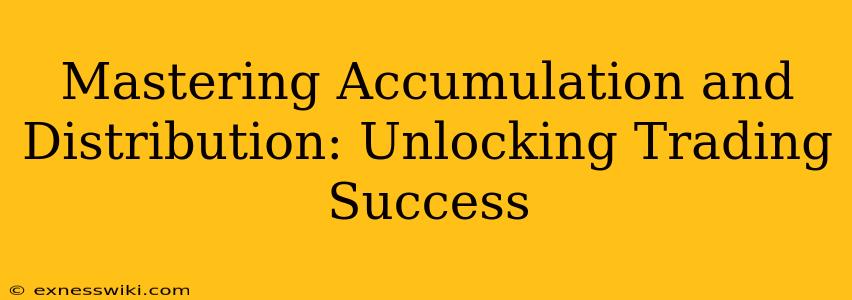I still remember the first time I saw the "distribution" pattern on a chart. It was like a hidden message, whispering secrets about the market's future. I, a young and eager trader, was instantly captivated. I was ready to dive headfirst into this new world of knowledge, eager to learn how to use it to my advantage. Little did I know, understanding accumulation and distribution would become a cornerstone of my trading journey.
Understanding Accumulation and Distribution: The Silent Language of the Market
Accumulation and distribution are powerful technical analysis concepts that help traders identify potential trends by analyzing the way price and volume interact on charts. Think of it as the market's way of communicating its intentions through subtle cues.
In my opinion, understanding these concepts is crucial for any serious trader. They provide invaluable insights into market sentiment and help us make better-informed trading decisions.
Unveiling the Secrets of Accumulation
Accumulation occurs when smart money, often institutional investors, quietly buy a specific asset, accumulating it over time. This process usually happens in a consolidation phase, where the price remains relatively stable while the volume increases. Here's how it unfolds:
- Price: Tends to stay within a defined range, often with a slightly upward bias.
- Volume: Increases as smart money starts accumulating the asset.
- Indicators: We often see positive divergence in indicators like the Relative Strength Index (RSI), suggesting a potential bullish breakout.
Examples of Accumulation Patterns:
- Ascending Triangle: A bullish pattern where the price consolidates within an upward sloping triangle.
- Cup and Handle: A U-shaped pattern that indicates a potential breakout to the upside.
- Rounded Bottom: A gradual price increase from a low point, indicating a potential reversal.
Decoding the Signals of Distribution
Distribution, on the other hand, signals the opposite. It's the process where smart money, having accumulated an asset, gradually sells it off, distributing it to other market participants. This usually happens during a consolidation phase, where the price remains stable or declines slightly.
Here's how it works:
- Price: Tends to stay within a defined range, often with a slightly downward bias.
- Volume: Increases as smart money starts distributing the asset.
- Indicators: We often see negative divergence in indicators like the RSI, suggesting a potential bearish breakdown.
Examples of Distribution Patterns:
- Descending Triangle: A bearish pattern where the price consolidates within a downward sloping triangle.
- Double Top: A pattern where the price reaches two similar highs before declining.
- Head and Shoulders: A pattern with three peaks, the middle peak being the highest, indicating a potential reversal.
The Art of Identifying Accumulation and Distribution: Practical Tips
- Focus on volume: Pay close attention to changes in volume. Increased volume during consolidation can signal accumulation or distribution.
- Analyze price action: Observe how the price moves within the consolidation range. Look for patterns like flags, pennants, or triangles, as they often precede breakouts or breakdowns.
- Use indicators: Employ indicators like the RSI, MACD, and Bollinger Bands to confirm potential accumulation or distribution.
- Look for confirmation: Don't rely on just one pattern or indicator. Look for multiple confirmations before entering a trade.
A Real-World Example: The Rise of Bitcoin
A prime example of accumulation can be seen in the rise of Bitcoin in 2017. As Coinbase, a leading cryptocurrency exchange, gained popularity, investors started accumulating Bitcoin, pushing the price higher and higher. This accumulation phase was characterized by increased trading volume and positive price action, culminating in a massive breakout to the upside.
Conclusion: Mastering the Language of the Market
Understanding accumulation and distribution is a crucial skill for any trader. These concepts help us identify potential trend reversals, anticipate market moves, and improve our trading decisions. By paying close attention to price action, volume, and key indicators, we can decipher the market's silent language and leverage its powerful signals to our advantage.
Remember, the market doesn't reveal its secrets easily. But with patience, discipline, and a deep understanding of accumulation and distribution, we can unlock the potential for trading success.
